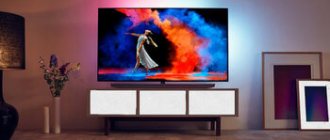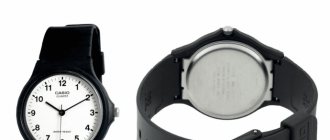TV manufacturers are trying to keep up with the times and are trying in every possible way to ensure that their devices are not inferior to computer technologies, and, if possible, replace them. This is why the Smart TV function was invented, which is now found on almost all more or less decent models. But making the right choice in 2021 is very difficult, because... the abundance of models simply confuses and confuses buyers. That's why we're bringing you today's selection of the 10 best 40-inch TVs you can find on sale.
Why is it worth buying a 40 diagonal TV?
Initially, we will explain why TVs with this diagonal are in great demand. The fact is that the size of this TV will allow you to install it in almost any room, except, perhaps, the bathroom. As for the living room, bedroom or kitchen, a 40-inch TV will find application everywhere.
All thanks to the fact that the diagonal of the TV will allow you to maneuver in terms of its installation. In order not to strain your eyes, you will need to install the TV in such a way that it is 2 - 2.5 m from your eyes, so that you do not damage your eyesight and, at the same time, can fully enjoy the content you are watching.
The most important thing is the presence of the Smart TV function, which will allow you not only to watch regular TV channels, but also to do your business on the Internet. This is not only online cinema and YouTube, but even search engines and visiting various sites. And below you will get acquainted with the highest quality and most functional TVs in this category.
Table of correspondence between TV diagonals and screen sizes - the most popular TV diagonals.
| TV diagonal in inches | TV diagonal in centimeters | Screen width in cm. | Screen height in cm. | TV width in cm. | TV height in cm. |
| 18,5 | 46 | 41,0 | 23,0 | 45,0 | 27,0 |
| 19 | 48 | 42,1 | 23,7 | 46,1 | 27,7 |
| 19,5 | 49 | 43,2 | 24,3 | 47,2 | 28,3 |
| 20 | 50 | 44,3 | 24,9 | 48,3 | 28,9 |
| 21,5 | 54 | 47,6 | 26,8 | 51,6 | 30,8 |
| 22 | 55 | 48,7 | 27,4 | 52,7 | 31,4 |
| 23,5 | 59 | 52,0 | 29,3 | 56,0 | 33,3 |
| 23,6 | 59 | 52,2 | 29,4 | 56,2 | 33,4 |
| 24 | 60 | 53,1 | 29,9 | 57,1 | 33,9 |
| 27,5 | 69 | 60,9 | 34,2 | 64,9 | 38,2 |
| 28 | 71 | 62,0 | 34,9 | 66,0 | 38,9 |
| 31,5 | 80 | 69,7 | 39,2 | 73,7 | 43,2 |
| 32 | 81 | 70,8 | 39,8 | 74,8 | 43,8 |
| 39 | 99 | 86,3 | 48,6 | 90,3 | 52,6 |
| 39,5 | 100 | 87,4 | 49,2 | 91,4 | 53,2 |
| 40 | 101 | 88,6 | 49,8 | 92,6 | 53,8 |
| 42,5 | 107 | 94,1 | 52,9 | 98,1 | 56,9 |
| 43 | 109 | 95,2 | 53,5 | 99,2 | 57,5 |
| 48,5 | 123 | 107,4 | 60,4 | 111,4 | 64,4 |
| 49 | 124 | 108,5 | 61,0 | 112,5 | 65,0 |
| 50 | 127 | 110,7 | 62,3 | 114,7 | 66,3 |
| 54,6 | 138 | 120,9 | 68,0 | 124,9 | 72,0 |
| 55 | 139 | 121,8 | 68,5 | 125,8 | 72,5 |
| 60 | 152 | 132,8 | 74,7 | 136,8 | 78,7 |
| 65 | 165 | 143,9 | 80,9 | 147,9 | 84,9 |
| 75 | 190 | 166,0 | 93,4 | 170,0 | 97,4 |
| 78 | 198 | 172,7 | 97,1 | 176,7 | 101,1 |
| 86 | 218 | 190,4 | 107,1 | 194,4 | 111,1 |
| 90 | 228 | 199,2 | 112,1 | 203,2 | 116,1 |
| 100 | 254 | 221,4 | 124,5 | 225,4 | 128,5 |
| 105 | 266 | 232,4 | 130,8 | 236,4 | 134,8 |
Thus,
TV 18.5 inches
has a diagonal of 46 centimeters. The screen size is 41.0x23.0 cm. And the body size is 45.0x27.0 cm.
TV 19 inches
has a screen with a diagonal of 48 cm. Screen size is 42.1 × 23.7 cm. Dimensions with frame are 46.1 × 27.7 cm.
TV 19.5 inches
screen diagonal 49 centimeters. Screen size 43.2x24.3 cm. Entire TV size 47.2x28.3 cm.
TV 20 inches
has a diagonal of 50 cm. Screen size is 44.3 × 24.9 cm. And body size is 48.3 × 28.9 cm.
TV 21.5 inches
has a screen with a diagonal of 54 centimeters. Screen size 47.6x26.8 cm. Dimensions with frame 51.6x30.8 cm.
TV 22 inches
screen diagonal 55 cm. Screen size 48.7x27.4 cm. Entire TV size 52.7x31.4 cm.
TV 23.5 inches
has a diagonal of 59 centimeters. The screen size is 52.0x29.3 cm. And the body size is 56.0x33.3 cm.
TV 23.6 inches
has a screen with a diagonal of 59 cm. Screen size is 52.2 × 29.4 cm. Dimensions with frame are 56.2 × 33.4 cm.
TV 24 inches
screen diagonal 60 centimeters. Screen size 53.1x29.9 cm. Entire TV size 57.1x33.9 cm.
TV 27.5 inches
has a diagonal of 69 cm. The screen size is 60.9 × 34.2 cm. And the body size is 64.9 × 38.2 cm.
TV 28 inches
has a screen with a diagonal of 71 centimeters. Screen size 62.0×34.9 cm. Dimensions with frame 66.0×38.9 cm.
TV 31.5 inches
screen diagonal 80 cm. Screen size 69.7x39.2 cm. Entire TV size 73.7x43.2 cm.
TV 32 inches
has a diagonal of 81 centimeters. The screen size is 70.8x39.8 cm. And the body size is 74.8x43.8 cm.
TV 39 inches
has a screen with a diagonal of 99 cm. Screen size is 86.3x48.6 cm. Dimensions with frame are 90.3x52.6 cm.
TV 39.5 inches
screen diagonal 100 centimeters. Screen size 87.4 x 49.2 cm. Entire TV size 91.4 x 53.2 cm.
TV 40 inches
has a diagonal of 101 cm. The screen size is 88.6x49.8 cm. And the body size is 92.6x53.8 cm.
TV 42.5 inches
has a screen with a diagonal of 107 centimeters. Screen size 94.1x52.9 cm. Dimensions with frame 98.1x56.9 cm.
TV 43 inches
screen diagonal 109 cm. Screen size 95.2x53.5 cm. Entire TV size 99.2x57.5 cm.
TV 48.5 inches
has a diagonal of 123 centimeters. The screen size is 107.4x60.4 cm. And the body size is 111.4x64.4 cm.
TV 49 inches
has a screen with a diagonal of 124 cm. Screen size is 108.5×61.0 cm. Dimensions with frame are 112.5×65.0 cm.
TV 50 inches
screen diagonal 127 centimeters. Screen size 110.7 x 62.3 cm. Entire TV size 114.7 x 66.3 cm.
TV 54.6 inches
has a diagonal of 138 cm. The screen size is 120.9 × 68.0 cm. And the body size is 124.9 × 72.0 cm.
TV 55 inches
has a screen with a diagonal of 139 centimeters. Screen size 121.8x68.5 cm. Dimensions with frame 125.8x72.5 cm.
TV 60 inches
screen diagonal 152 cm. Screen size 132.8×74.7 cm. Entire TV size 136.8×78.7 cm.
TV 65 inches
has a diagonal of 165 centimeters. The screen size is 143.9x80.9 cm. And the body size is 147.9x84.9 cm.
TV 75 inches
has a screen with a diagonal of 190 cm. Screen size is 166.0×93.4 cm. Dimensions with frame are 170.0×97.4 cm.
TV 78 inches
screen diagonal 198 centimeters. Screen size 172.7 x 97.1 cm. Entire TV size 176.7 x 101.1 cm.
TV 86 inches
has a diagonal of 218 cm. The screen size is 190.4 × 107.1 cm. And the body size is 194.4 × 111.1 cm.
TV 90 inches
has a screen with a diagonal of 228 centimeters. Screen size 199.2×112.1 cm. Dimensions with frame 203.2×116.1 cm.
TV 100 inches
screen diagonal 254 cm. Screen size 221.4×124.5 cm. Entire TV size 225.4×128.5 cm.
TV 105 inches
has a diagonal of 266 centimeters. The screen size is 232.4x130.8 cm. And the body size is 236.4x134.8 cm.
These are reference values. Case size may vary slightly depending on manufacturer and model, as... The thickness of the frame around the screen varies slightly between different TV models.
What to look for when choosing the best 40 inch TV
Below are the main characteristics that you should pay attention to when buying a TV in order to get not just a good device, but also maximum functionality in the appropriate price category.
Screen resolution
Screen resolution is a value that denotes the ratio of the number of color dots, pixels that form an image, in the horizontal and vertical directions. The more pixels in the screen matrix, the clearer the reproduced image.
Today the highest resolution is 4K (4096x2160). The image on this TV is brighter and clearer than its predecessors UHD (3840 x 2160) and FuLL HD with a resolution of 1920 x 1080 pixels (1080p).
However, it is worth noting that UHD models are often advertised as 4K, and in order not to fall for the bait of marketers, it is worth double-checking the resolution.
When buying a 40-inch TV, FuLL HD and UHD resolutions are perfect for the average user, because the difference in the image on a small screen is almost unnoticeable, but the price is quite large.
Availability of HDR technology
Not many people know what HDR does, but this technology has a much stronger effect on image quality than simply increasing the resolution. HDR improves pixel quality, making images appear more realistic on screen. This happens due to the advanced backlighting of the screen, which releases brightness where it is needed (where the sun is shining), increasing contrast. TVs with this function have a brightness reserve several times higher than ordinary ones: up to 1,000–1,500 nits (standard HDR TVs have 300–400 nits).
In addition, the format helps to transmit colors previously unavailable for transmission on the screen, so the image becomes richer, more realistic and clearer, which causes a “wow” effect from the difference.
When asked whether this function is really so important, experts answer that this is the first significant leap in development after the transition from SD (Standard Definition) to HD television (High Definition TV).
Screen frequency
Screen refresh rate is an indicator showing how many times in one second the TV changes frames on the screen. It is measured in Hertz Hz.
High frequency ensures smooth images and clear storyboards of moving objects. That is, a person running on the screen will not “crumple”.
Important! The smoothness of the image is also affected by the fact that each frame is duplicated. This also reduces flicker, which negatively affects vision and well-being when watching TV.
The minimum acceptable value is 50-100 Hz, and 200 Hz is considered normal. Well, the higher the better, the image at 400 Hz is much more dynamic, but models with this parameter are much more expensive.
Note! A frame refresh rate that is too high, for example 1200 Hz, although it may be real if it is a product of a well-known brand, the human eye will not see it and will not be able to check it.
Backlight type
The type of backlight is how the LEDs are arranged, depending on which the characteristics of the matrix change. Today there are four types of backlight:
- Edge LED . LEDs are placed along the contour of the screen - a kind of luminous frame. These TVs are thin and economical and have a good viewing angle.
- Direct LED. LEDs are located along the entire plane of the screen. You can perform local dimming or adjust each diode separately, and the resulting image will become clearer and more contrasty.
- QLED . There is no “illuminating” block, and the illumination function is performed by quantum dots. Such screens convey colors that are more comfortable for the human eye. The image is bright and as natural as possible.
- OLED. Diodes are also used here, but they are coated with phosphor, a substance that glows when an electric pulse passes through. The viewing angle is small, but viewing is as comfortable as possible for the eyes.
The OLED screen type is recognized as the best today, but its cost is an order of magnitude higher than the alternatives. Therefore, here you should focus more on the budget.
Smart TV technology
Smart TV is a set of functions that I can use from a regular TV:
- search for information on the Internet;
- Watch movies online;
- view your feed on social networks;
- download applications for video streaming;
- make video calls.
But this technology has a significant drawback: you will have to control Smart using the remote control, and this is quite long and tedious. Therefore, this feature is not very popular among buyers. If there is no special need, then you can safely choose a model without Smart TV, saving a lot of money.
WiFi support
Wi-Fi-enabled TVs are devices with a built-in module that automatically finds and connects to a wireless Internet network. Using this TV, you can open presentations, use various applications (Skype, Viber, WhatsApp) and play online videos.
This is a very useful option, and if you don’t have one, you can purchase a wireless adapter that connects to the TV via HDMI or USB.
Number of built-in tuners
A tuner is a device that receives and decrypts digital television signals. It can be built directly into the TV, one or several, or individual.
Built-in tuners can process a television signal in one or more broadcast formats.
Most often, DVB-T/C tuners are built into TVs. If the specifications for the TV indicate DVB-T/C/S, then it will receive a digital signal from terrestrial, cable and satellite television.
But even if the purchased TV does not have a built-in tuner corresponding to the type of signal, you can always buy a separate one.
3D support
3D is a three-dimensional image that some TVs support. This technology developed with great strides, but soon stopped developing and large companies abandoned the production of such TVs.
They primarily justify this by saying that production costs were very high and sales were low. Consumers also complained of headaches and eye fatigue when watching, which undermined interest in the 3D format. The third reason is the lack of relevant content, although many disagree with this.
You can find a 40-inch TV with 3D support, but you should take into account that the prices for such a model will be higher.
Additional Information. A fairly large part of the population has such a visual feature as stereoblindness - the inability to perceive the depth of an object, its three-dimensional image. This manifests itself as unpleasant sensations and even headaches when watching 3D films. At the same time, in ordinary life, people may not complain about their vision.










